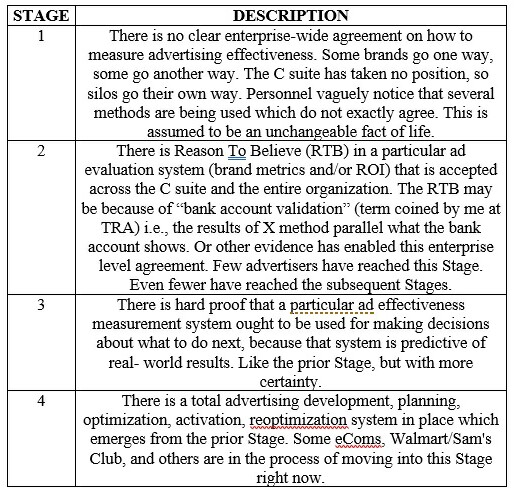Google and Apple ID Data Changes Compel Brands to Reach Consciousness Stage Four

Google and Apple are putting up barriers to the deterministic matching of data the industry has gotten accustomed to using. Indeed, these steps follow world lawmaking shifts to greater privacy protection, and world advertiser shifts to avoiding excessive use of retargeting as discussed in my previous column. How they affect a brand depends upon the brand's stage in the evolution of its advertising value consciousness, as explained below, because the times demand a clear understanding of why the brand ought to use a particular key performance indicator (KPI) versus another, and the KPI chosen has an impact on the degree to which one benefits from deterministic match data at scale.
What are the stages of brand consciousness? Let's begin with an analogy. Scientists speak of there being three stages of civilization:
- Those which have not achieved space travel: Stage One Civilizations
- Those which have space travel within their own solar systems: Stage Two Civilizations
- Those which have attained space travel among the stars: Stage Three Civilizations
In marketing, the understanding of how to value specific advertising campaigns has not evolved very far. But there have been huge leaps. Twenty years ago, the global advertising industry generally believed that advertising sales effects could not be measured outside of direct marketing. Today there is widespread use of Marketing Mix Modeling (MMM), Multitouch Attribution (MTA), Singlesource, National Time Series, Matched Market Trials and Random Control Trials (RCTs), primarily addressing sales effects or proxies for same. Alongside those there are brand lift and tracking studies which focus on upper funnel branding metrics. All of these present differing (yet sometimes consilient) evaluations of an advertising campaign that has run or is still running.
Some of these ad evaluation methods are more dependent than others upon the ability to deterministically match IDs.For example, MMM, National Time Series and Matched Market Trials are not dependent upon the ability to match IDs deterministically, whereas MTA, Singlesource and RCTs in general are highly dependent upon such matching. These therefore will be the techniques that are most deprecated by the reduction in ID matchability.
Experts whom I trust are estimating that for those who have been using masses of digital inventory, match rates will probably decrease to about a third of what they are now.
This will lower the accuracy of the ROI measurement methods that are dependent upon ID matching, except in the cases where publishers have strong ID data that will still be usable by marketers. This latter advantage will greatly benefit MVPDs, AVODs, Digital Print (Meredith, Hearst, et al), Smart TV manufacturers and purveyors of connective devices (Roku, Amazon, et al), especially as advertisers and agencies make their cautious shifts to these platforms from today's dominant digital platforms specifically because of ID matchability.
Within advertiser organizations there are four Stages of understanding of how to evaluate the effectiveness of advertising:

Let's say that you are an eCom/DTC. The value to you of retargeting and being able to track a specific household over time is very high; it's basic to your business. You need high match rate deterministic targeting and will be among the first to shift from today's dominant platforms to those which retain these core capabilities. The more you can get households to reveal their identity to you in order to invite a closer relationship the better. Dealing with cohorts or aggregates of any kind is not going to do you a lot of good.
The higher up you are in the Stages the more obvious this will be to you. It will not be hard to convince others in your organization and you can take advantage of Google and Apple publicity right now to state your case to engage inventory suppliers that preserve your right to "market with a memory" -- a phrase of Lester Wunderman's preserved by Joel Tucciarone.
Lester's concept of Syllabus Marketing envisions breaking a long advertising story down into bitesize chunks presented in sequential direct mail pieces or via whatever sequential touchpoints one can control. Those using such techniques today will be forced to shift dollars from Google and Facebook to MVPDs, digital print and the other media supply side players who retain hard IDs while protecting consumer identity until the consumer decides to reveal identity to the advertiser.
Let's say you don't have a long, complicated story to tell. Let's say you are a typical CPG brand. How important is the individual household level data to you?
Looking at the TRA experience, 77 brands across dozens of advertisers discovered they could get an average increase in ROI of +28% simply by increasing the density index of Heavy Swing Purchasers (category heavies who have bought the brand but not loyally). If the index of HSPs in the campaign goes up 10 points, the ROI will go up seven points. This discovery does not necessarily reach the highest possible lifts were the technique to be combined with others (e.g., RMT ad-context psychological resonance), but it illustrates that for ads without Calls to Action (CTAs), targeting by contexts such as programs or websites can be carried out in ways that produce higher ROI without needing to target by IDs.
However, someone has to be able to match ad exposure to purchase deterministically (e.g., TRA, Nielsen Catalina, Marketing Evolution, 605, Videoamp, et al) for the system to work. If ad tags from behind walled gardens cannot be matched into these systems, the walled gardens will not be able to be ROI measured at scale even using context buying plus systems like TRA. If the Stage Four company knows how to truly measure ROI, it will under those conditions shift dollars away from the black box to the white box.
ARF's RCT-21 initiative teaches that Intent to Treat can be used to measure the efficacy of walled gardens. One uses dollars in and dollars out and ignores impressions as an interim measure that is not needed. If e.g., YouTube receives the First Party IDs of an advertiser, the advertiser can see whether they get incremental sales from those IDs or not and calculate the return vs. the media cost. However, YouTube may or may not continue to allow such targeting. Important details like that have not yet been announced.
This is a very good time to up your game on the measurements you depend upon for decision making. My advice: Stage Four full speed ahead!
Click the social buttons above or below to share this content with your friends and colleagues.
The opinions and points of view expressed in this content are exclusively the views of the author and/or subject(s) and do not necessarily represent the views of MediaVillage.com/MyersBizNet, Inc. management or associated writers.


